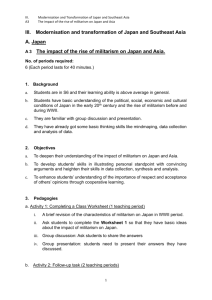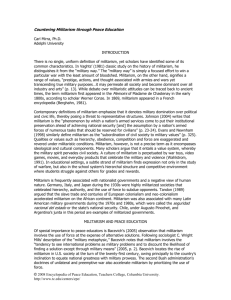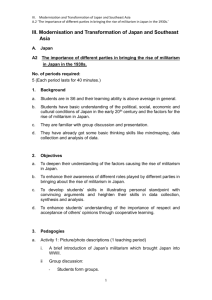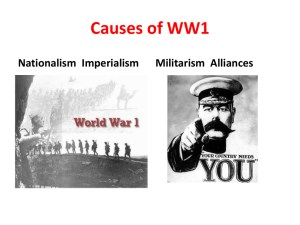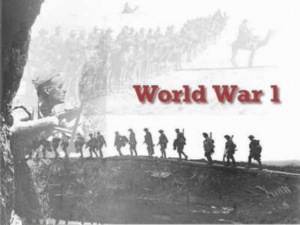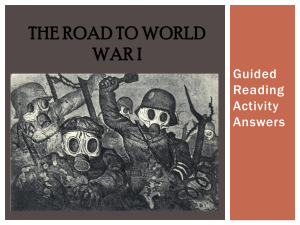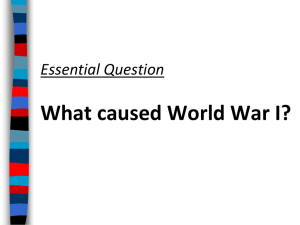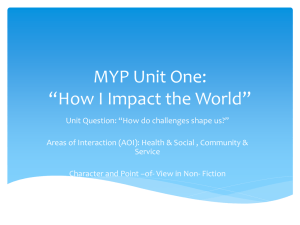lecture 24 militarism 2012 -
advertisement
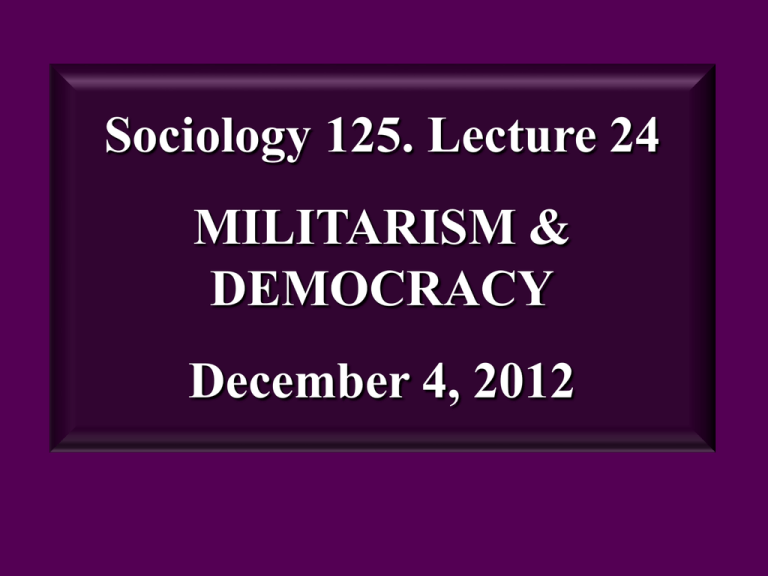
Sociology 125. Lecture 24 MILITARISM & DEMOCRACY December 4, 2012 I. INTRODUCTION I. INTRODUCTION 1. The conventional view by Americans about War and Peace in the United States We use our military power to defend freedom, to defend democracy, to protect America, but not to dominate other countries. We are defenders not aggressors. 2. The reality: (a) We spend vastly more than any other country in the world on the military (b) We use military threats and intervention as a central instrument of foreign policy, including overthrowing democratically elected governments (c) Our domestic affairs are severely affected by the global role of our military; we have a heavily militarized economy. I. INTRODUCTION Military Budgets, 2008 I. INTRODUCTION LIST OF U.S. MILITARY INTERVENTIONS , 1945-2010 GREECE 1947–49 U.S. directs extreme right in civil war. PHILIPPINES 1948–54 CIA directs war against Huk Rebellion. KOREA 1951–53 Korean War IRAN 1953 CIA overthrows democracy, installs shah. GUATEMALA 1954 CIA directs overthrow of democratic government LEBANON 1958 Marine occupation against rebels. VIETNAM 1960–75 Vietnam War LAOS 1962 Military builds up defenses during guerrilla war. CUBA 1961 CIA-directed exile invasion fails. INDONESIA 1965 Million killed in CIA-assisted army coup. DOMINICAN REP. 1965–66 Marines land during election campaign. GUATEMALA 1966–67 Green Berets intervene against rebels. CAMBODIA 1969–75 Secrete Bombing LAOS 1971–73 U.S. directs South Vietnamese invasion. CHILE 1973 CIA-backed coup ousts elected Marxist president. ANGOLA 1976–92 CIA assists South African–backed rebels. EL SALVADOR 1981–92 Advisors, overflights aid anti-rebel war. AFGHANISTAN 1979–89 CIA supports mujahideen fight against Afghan regime and Soviet army. NICARAGUA 1981–90 CIA directs exile (Contra) invasions. LEBANON 1982–84 Marines expel PLO and back Phalangists. GRENADA 1983–84 Invasion occurs four years after revolution ousts regime. IRAN 1984 Two Iranian jets shot down over Persian Gulf. LIBYA 1986 Air strikes to topple nationalist government. IRAN 1987–88 U.S. intervenes to protect Iraqi tankers in Iran war. PANAMA 1989 Nationalist government ousted by 27,000 soldiers. KUWAIT 1991 First Gulf War SOMALIA 1992–94 U.S. leads United Nations occupation during civil war. BOSNIA 1993–? No-fly zone in civil war; downed jets, bombed Serbs. HAITI 1994 Troops restore Aristide to office three years after coup. YUGOSLAVIA 1999 Heavy NATO air strikes after Serbia declines to with draw from Kosovo. AFGHANISTAN 2001–? Afghanistan War COLOMBIA 2003–? U.S. special forces sent to rebel zone. IRAQ 2003–? Iraq War Science & environment Education & Jobs Nonmilitary international 2.2% 2.5% 1.5% Administration 7.0% Total Military (including interest from past wars) Interest 10.9% 44.4% Anti-poverty 11.8% Health care 19.7% Military Spending as a Proportion of Federal spending, 2009 I. INTRODUCTION 3. What is Militarism? Definition: Militarism is a political and ideological orientation towards international affairs in which: 1. The threat and use of military power is a central strategy of international policy. 2. The military plays a pervasive role in the internal economic and political life of a country. 3. Military preparedness is the highest priority of government policy. Militarism is an “institution”, not a “policy”: Militarism is not just the “policy” of a particular administration; it is deeply embedded in our economic, political, and social institutions. This means that it creates a very broad range of interests – or corporations, workers, politicians, military personnel, and others – that interlock and depend upon militarism. It is a system. The intensity may vary over time, but it is broadly defended by both major political parties. II. The Historical Trajectory of American Militarism I. Historical II. HistoricalTrajectory Trajectory 1. Founding Fathers and the early Republic At the founding of the United States there was great skepticism about the Military and the use of military power for national objectives. There was widespread objection to the idea of a standing army. George Washington: “Overgrown military establishments are under any form of government inauspicious to liberty, and are to be regarded as particularly hostile to Republican liberty.” Farewell Address 1796 I. Historical II. HistoricalTrajectory Trajectory James Madison: “Of all enemies to public liberty, war is, perhaps, the most to be dreaded, because it comprises and develops the germ of every other. War is the parent of armies; from these proceed debts and taxes; and armies, debt and taxes are the known instrument for bringing the many under the domination of the few .” Nearly 200 years later, Eisenhower affirmed the same worry: “This conjunction of an immense military establishment and a large arms industry is new in the American experience…In the councils of government, we must guard against the acquisition of unwarranted influence…of the military industrial complex. The potential for the disastrous rise of misplaced power exists and will persist. We must never let the weight of this combination endanger our liberties or democratic processes. We should take nothing for granted.” http://www.youtube.com/watch?v=CWiIYW_fBfY&feature=p layer_detailpage#t=403s I. Historical II. HistoricalTrajectory Trajectory 2. 19th century ambivalence The worry about standing armies confronted another core American idea: the importance of military power for the conquest of lands in North America itself. This became crystallized as Manifest Destiny: the belief that the United States then on the Eastern part of North America had a natural right to expand westward to the Pacific Ocean. • Military power was essential for displacing Native Americans in the expansion to the West • The Mexican War of 1848 was a war of invasion and conquest I. Historical II. HistoricalTrajectory Trajectory 3. The Spanish American War • This launched U.S. militarism on a global scale • • • included imperialist suppression of a conquered people Philippine resistance was the starkest example: 200,000 Filipinos killed in the 1901-1903 repression. ideologically defended on racial and cultural grounds 4. Building a modern Military Bureaucracy • • Before Spanish American War, a very amateurish, disorganized military In the period leading up to WWI there occurred the first efforts to seriously bureaucratize and modernize the military I. Historical II. HistoricalTrajectory Trajectory 5. WWI • • • • • • This is the decisive turning point for the formation of a substantial, modernized military Ideological Crusades: WWI also deepened the use of military power under the banner of ideological crusades (see Chalmers Johnson). Wilson was a crucial architect of this. Intervention in Mexican revolution was to teach the mechanisms democracy WWI was fought under the slogans “making the world safe for democracy” and “the war to end all wars”. Ideological crusades become a permanent feature of American foreign policy and militarism (this is both ideological cover and a sincerely felt set of commitments) After WWI there was substantial demilitarization: we did not become a militarized economy I. Historical II. HistoricalTrajectory Trajectory 6. WWII & The Cold War • WWII was by far the greatest military mobilization in American history • After the War there was some expectation of demilitarization • The Cold War ended that possibility: the result is more than half a century of military budgets over $300 billion dollars and often over $400 billion. I. Historical II. HistoricalTrajectory Trajectory 600 Billions of 2009 dollars 500 400 300 200 100 0 1950 1955 1960 1965 1970 1975 1980 1985 1990 1995 Department of Defense Budget, 1950-2008 2000 2005 I. Historical II. HistoricalTrajectory Trajectory 7. Effects of 65 years of interventions & military spending • Defense contracts are the single most important way that the government intervenes in the economy, providing jobs, research, technical change, and economic stimulation. The livelihood of millions of Americans depends upon military spending. And, • Ultimately, this depends on war: in the absence of war it is almost impossible to maintain over a long period of time huge military spending, so the deep dependency of the economy on militarism itself promotes militarism. • Massive Military spending almost inevitably breeds corruption. Because military contracts are surrounded by secrecy under the shield of “national security” and “classified information”, it is almost impossible to have adequate monitoring of military spending. I. Historical II. HistoricalTrajectory Trajectory 8. The 21st Century? • There was much talk in the 1990s of the “Peace Dividend” and how this might open up policies for a wide range of important public investments: environmental protection, energy transformation, high speed rail, rebuilding infrastructure. • 9/11 and the “War on Terrorism” ended such discussion • The last five years have lead to a significant intensification of previous militarism. III. Motivations III. Motivations for Militarism today: the problem of “Empire” Key general point: There is no single overriding factor or motive that explains American militarism. Most pervasive, durable features of a social system are supported through complex combinations of interests and motivations rather than some single overriding goal. This is what it means to say militarism is an “institution” : it becomes self-perpetuating because the multiplicity of interests that support militarism mutually reinforce each other and are in significant ways reproduced by militarism itself. III. Motivations Motivation #1: Narrow Economic Interests • The U.S. uses military power to defend its narrow economic interests. • In the present period this is especially important for oil • The broader context is looming shortages in the future and competition with China • While it is an oversimplification, it is certainly the case that a good deal of our military interventions in the last 15 years occurred in areas where we have interests in oil (next slide) III. Motivations New U.S. military base clusters 1. Gulf War, 1991 2. Yugoslav wars, 1990s 3. Afghan War, 2001 4. Iraq War, 2003 Bases built to wage wars, or wars waged to build bases? U.S. sphere of influence growing between economic competitors in EU & Asia Prepared by Zoltan Grossman Z article available III. Motivations Motivation # 2. Maintenance of general global economic dominance of American based multinational corporations. • Large, American-based corporations make investments all over the world. American military power has often been used to open-up markets for those corporations, to prevent governments from interfering too much with those investments, to basically safeguard the world economy for corporate investment. • 1950s: overthrow of elected government in Guatemala and Iran because of direct threats to U.S. Corporations Motivations #1 and #2 are often referred to as “imperialism” III. Motivations Motivation # 3. National security. • This is certainly an important motivation • Few people deny the relevance of an effective national defense • However: there are deep disagreements about whether militarism as such is mainly a matter of defense rather than the aggressive pursuit of national interests • In the Cold War anti-militarists and anti-imperialists argued that strengthening international institutions and cooperation would actually be a better defense III. Motivations Motivation # 4. Distinctive interests of the military-industrial complex itself. • This is an important part of the political coalition that supports militarism • Cuts in military programs hurt powerful corporations, workers and communities. The result is the military contractors form a coalition with regional politicians and workers whose jobs are threatened by reductions in military spending and fight for military budgets. • To justify such budgets you need threats. • Exaggerating military threats thus is a constant strategy to maintain military spending • Alternative ways of spending money to stimulate the economy are possible – domestic infrastructure, etc. – but these open the door for a broader “affirmative state” and are therefore opposed. III. Motivations Motivation # 5. Ideological Crusades The precise character of the crusade changes from time to time, but its core is the belief that the United States has a divine mission to spread its values and way of life around the world, not just because this is in our narrow national interests but also because it is the right thing to do – or even stronger, because we are doing God’s work by extending our institutions globally. This continues to play a role today, as seen in this Bush Administration National Security Document: “[there is] a single sustainable model for national success….that is right and true for every person in every society…The United States must defend liberty and justice because these principles are right and true for all people everywhere” This crusading ideology is probably not the driving motivation for militarism, but it does help to cement the political support. IV. CONSEQUENCES IV. CONSEQUENCES OF MILITARISM IV. CONSEQUENCES 1. Perpetual War • Constant development of new technologies to reduce US casualties and make interventions even easier, even though these may increase what we euphemistically call “collateral damage” • Aggressive, interventionist posture around the world provokes reactions in response to our interventions. This is sometimes called “blowback”: terrorism in response to militarism. • This terrorism then provides justifications for further intervention and militarism. IV. CONSEQUENCES 2. Reduction of democracy at home • Increasing concentration of power in the presidency: the president can bring us to war virtually on his own initiative. • Military priorities are bolstered by intensified fear, and people are more willing to give up civil liberties when they are afraid: The Patriot Act as an example. Militarism is at the center of the politics of fear • Militarism pre-empts other forms of state spending, and this curtails the scope of democratic deliberation about the public good. • Militarism undermines democratic political culture. In debates over domestic priorities people can see their opponents as legitimate. In a militarized context of debates over war and security, opponents are treated like traitors. IV. CONSEQUENCES 3. Degradation of Information Information warfare and deception as official policy. The War on Iraq has been a stunning example of this: lies and deception have become a routine policy. This was true in the Vietnam War, and it is true again. When combined with the problems of corporate control over the media, we face a deep crisis in information. IV. CONSEQUENCES 4. National Bankruptcy looming economic catastrophe for the United States as our national debt increases massively under the pressures of military spending (especially when combined with massive tax cuts). This debt is held by foreign governments. The enormous trade deficit further places us in a precarious position It is only the global power of the US that prevents this debt load from crashing down as in Argentina or Russia. But it cannot go on forever, and the result really could be an economic meltdown.

